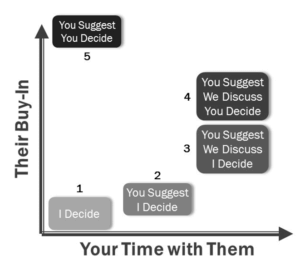Adapted from the course The Facilitative Leader
Your employees want you to delegate more and micromanage less. You want to make sure that they understand the big picture before making decisions. In this article, which is adapted from our course, The Facilitative Leader, and my book, The 8 Core Practices of a Facilitative Leader, we recommend a progressive approach that helps you increase buy-in by allowing your employees to make decisions while helping you to increase your level of trust in their decision-making ability.
To achieve higher levels of leadership, you must develop your people to accept higher levels of leadership responsibility. The Decision Matrix that follows offers a vehicle for achieving this. Consider the two axes. The X-axis is the amount of time you spend with your people in making a decision. The Y-axis is the level of their buy-in to the decision. Notice that as you progress from stage 1 through stage 5, both the level of empowerment and the level of buy-in increases.

Stages of the Decision Making Matrix
- In Stage 1, you are making all the decisions. You are neither seeking input nor getting input from others. While it takes little time WITH THEM to make the decisions, the result is very low buy-in by others.
- In Stage 2, you are open to suggestions but you still make all decisions. Taking suggestions tends to increase buy-in by others, but as you can see, it also requires more time.
- Stage 3 requires even more time as you are discussing the suggestions of others. But as before, you decide. This is the beginning of the coaching phase. In this stage you have the opportunity to discuss your team’s recommendations, to hear their rationale, and to help them understand why you might agree or disagree. Remember that in order to delegate, you must trust. And trust has five different dimensions: Caring, Competence, Commitment, Communication and Character. In listening to their rationale, and having them listen to your rationale, you’re able to increase your level of comfort with their competence and communication style. Stage 3 can also promote increased caring by giving them an opportunity to understand your concerns.
- Stage 4 involves a significant shift in the decision-making. In Stage 4, you are open to suggestions and you discuss their suggestions. However, the final decision is up to the team member. While this entails the same amount of time as Stage 3, notice that Stage 4 significantly increases buy-in. You can progress to Stage 4 only after increasing your level of comfort, especially with their competence and commitment.
- Stage 5 entails another major shift in the decision-making. In this final stage, you have full trust in the other decision makers. You believe they have the caring, competence, commitment, and communication skills that allow you to be fully comfortable with delegating decision-making authority. Notice that Stage 5 has some increase in buy-in, but significantly decreases your time! By moving more and more people to Stage 5, you become more productive and they are able to operate with full autonomy.
Consider meeting with your team members individually. Ask them to identify the stage at which they believe decisions are currently being made and to identify the stage where they want decision-making to be made. The schematic can help those who feel they’re being micromanaged to see some light at the end of the tunnel. Develop a plan together for moving up the decision-making diagram, keeping in mind the Five Cs of Trust.
For more techniques on managing effectively and building leadership skills, consider our course, The Facilitative Leader.
About the Author
Michael Wilkinson is the CEO and Managing Director of Leadership Strategies, the largest provider of professional facilitators and facilitation training in the country. Michael is a much sought after trainer, facilitator and speaker. He is a Certified Master Facilitator and a Certified Professional Facilitator. As a past president of the Southeast Association of Facilitators, the creator of the FindaFacilitator.com database and a board member of the International Institute of Facilitation, Michael is a national leader in the facilitation industry. You can get more tips from Michael’s books, including The Executive Guide to Facilitating Strategy, The Secrets of Facilitation, The Secrets to Masterful Meetings, and CLICK: The Virtual Meetings Book.

